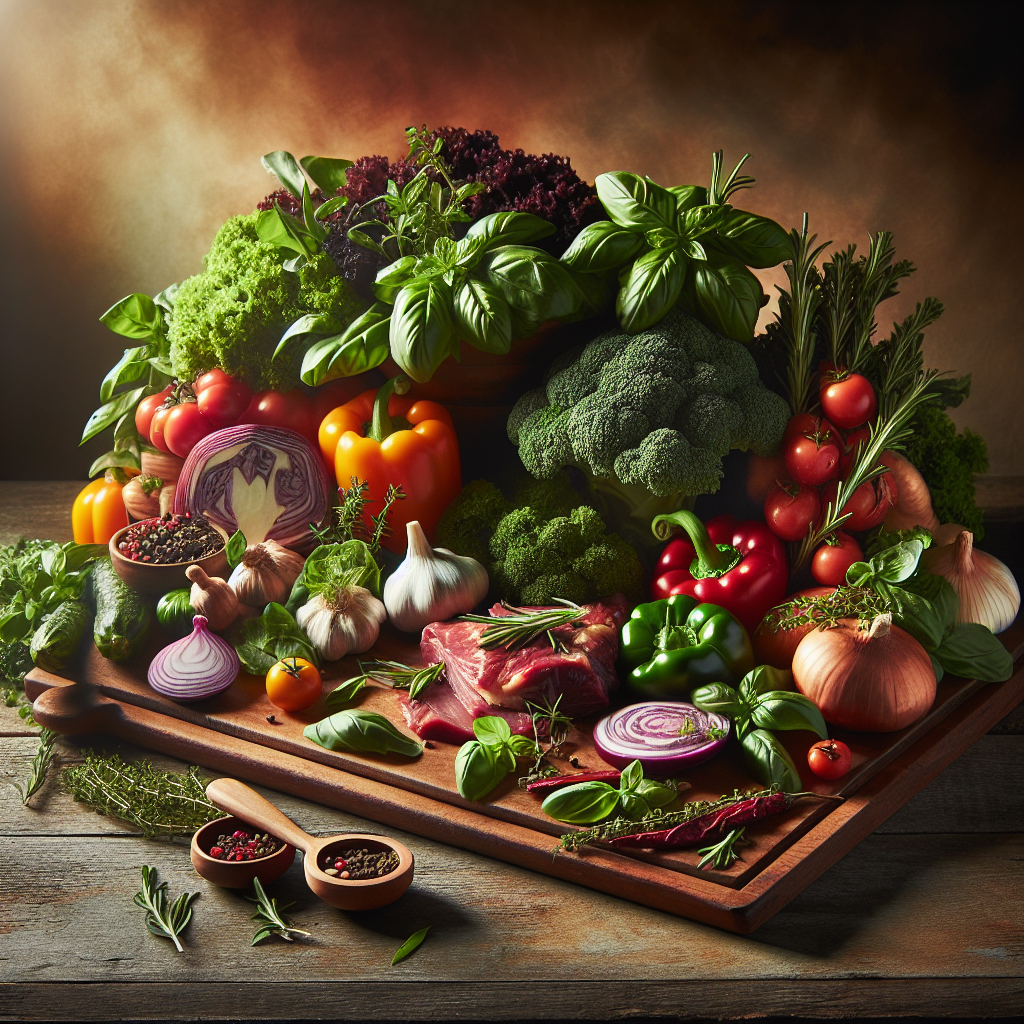Are you tired of ordering takeout every night or relying on pre-packaged meals? If you’re looking to elevate your cooking skills and impress yourself and others with delicious home-cooked meals, then this article is for you. In “How To Master Home Cooking Techniques,” you’ll find practical tips and useful advice to help you become a confident and skilled cook in the comfort of your own kitchen. Whether you’re a beginner or have some experience, this guide will equip you with the essential techniques needed to create mouthwatering culinary creations. So put on your apron, grab your favorite recipe book, and get ready to embark on a culinary journey like no other!

Choosing the right ingredients
When it comes to cooking, the quality of your ingredients can make all the difference in the final result. Understanding ingredient quality is essential for taking your dishes to the next level. Whether you’re cooking a simple weeknight dinner or experimenting with a new recipe, selecting the right ingredients will ensure that your dish is full of flavor and texture.
Understanding ingredient quality
Ingredient quality refers to the overall freshness, flavor, and nutritional value of the ingredients you use in your cooking. Fresh, high-quality ingredients can elevate even the simplest of dishes. When shopping for ingredients, pay attention to signs of freshness, such as vibrant colors, firm textures, and pleasant aromas. Opt for locally sourced produce and meats whenever possible, as they are often fresher and more flavorful than those that have traveled long distances.
Selecting fresh produce
When choosing fresh produce, look for fruits and vegetables that are firm, bright in color, and free from blemishes or bruises. Avoid any produce that feels soft or wilted, as it may be past its prime. Additionally, consider the seasonality of the produce you are purchasing. Fruits and vegetables that are in season tend to be at their peak flavor and nutritional value.
Choosing the right cuts of meat
Selecting the right cuts of meat is crucial for achieving tender and flavorful results. Different cuts of meat vary in fat content, tenderness, and flavor. For example, lean cuts like chicken breasts are best for quick cooking methods like sautéing or grilling, while tougher cuts like beef chuck benefit from slow cooking techniques such as braising or roasting. Consider the desired outcome of your dish and choose the appropriate cut of meat accordingly.
Using high-quality spices and seasonings
Spices and seasonings play a vital role in adding depth and complexity to your dishes. Opt for high-quality spices and seasonings to enhance the flavors of your meals. Look for aromatic spices and herbs with vibrant colors and strong aromas. Consider experimenting with different spice blends and seasonings to create unique flavor profiles. Grinding whole spices just before using them will also ensure maximum flavor.
Mastering knife skills
Knife skills are fundamental in the culinary world and can significantly improve your efficiency and precision in the kitchen. Proper knife handling techniques are essential for ensuring safety and achieving consistent, professional-looking cuts. Whether you’re chopping vegetables or deboning a chicken, mastering knife skills will make your cooking experience more enjoyable and efficient.
Choosing the right knife
Using the right knife for the task at hand is crucial for achieving clean and precise cuts. Different types of knives are designed for specific purposes. A chef’s knife is a versatile tool that can handle most cutting tasks, while a paring knife is ideal for delicate work like peeling or trimming. Investing in a high-quality, sharp knife will make a noticeable difference in your cooking experience.
Holding the knife correctly
Properly holding a knife not only ensures safety but also allows for more control and efficiency. Place your index finger and thumb on the base of the blade, ensuring a firm grip. Wrap your remaining three fingers around the handle for stability. Maintain a relaxed grip and let the weight of the knife do the work as you cut. Regularly practice your grip and technique for improved mastery.
Mastering basic cutting techniques
Learning basic cutting techniques will greatly enhance your ability to prepare ingredients efficiently. Start by mastering the common cutting techniques: chopping, mincing, dicing, and julienning. Each technique requires a different style of knife grip and motion. Practice these techniques regularly to build muscle memory and increase your speed and precision.
Learning advanced knife skills
Once you have a solid foundation in basic cutting techniques, you can start exploring more advanced knife skills. Techniques such as brunoise, chiffonade, and filleting require more finesse and precision. Advanced knife skills allow for more intricate and visually appealing presentations in your dishes. As with any skill, practice and patience are key to mastering these techniques.
Understanding heat and temperature
Heat is an essential element in the cooking process, and understanding how to control and manipulate it is crucial for achieving desired results in your dishes. While heat and temperature are often used interchangeably, they have distinct meanings in the culinary world. Understanding the difference between the two and knowing how to use them effectively will take your cooking to new heights.
Differentiating between heat and temperature
Heat refers to the energy transferred from a heat source to the food being cooked. It is the driving force behind the cooking process. Temperature, on the other hand, is a measurement of the average kinetic energy of the molecules in a substance. While heat affects temperature, temperature alone doesn’t determine the intensity of the cooking process.
Using the right heat source
Different cooking methods require specific heat sources. Gas stovetops, electric burners, ovens, and grills each have their own advantages and limitations. Understanding which heat source to use for each cooking technique will ensure optimal results. Gas stovetops offer precise control over heat levels, while ovens provide even, ambient heat for baking and roasting. Consider your recipe and the desired outcome to determine the most appropriate heat source.
Controlling heat levels
Controlling heat levels is essential for avoiding overcooking or undercooking your ingredients. Adjusting the flame or dial on your heat source allows you to increase or decrease the intensity of the heat. For stovetop cooking, start with a medium heat and adjust as necessary. When using an oven, preheat to the recommended temperature and monitor the progress of your dish accordingly.
Mastering different cooking temperatures
Different ingredients and cooking techniques require specific cooking temperatures. Understanding the optimal cooking temperatures for different foods will help you achieve the desired results. From searing a steak to baking a cake, each dish has its own temperature requirements. Use a thermometer to accurately measure the internal temperature of meats and test for doneness.
Basic cooking methods
Mastering basic cooking methods will give you a solid foundation for creating a variety of dishes. Each cooking method offers unique flavors, textures, and cooking times, allowing for endless culinary possibilities. By mastering these methods, you’ll gain the confidence to experiment with recipes and even create your own culinary creations.
Sautéing and stir-frying
Sautéing and stir-frying are quick cooking methods that involve cooking small pieces of food over high heat in a small amount of oil or fat. These methods require constant stirring or flipping to ensure even cooking. Sautéing is typically done on a stovetop, while stir-frying is often done in a wok. Both methods produce flavorful, tender results in a short amount of time.
Boiling and simmering
Boiling and simmering are moist-heat cooking methods that involve cooking food in a liquid at or near its boiling point. Boiling involves rapidly cooking food in a large amount of liquid, while simmering gently cooks food at a lower temperature. These methods are commonly used for cooking pasta, vegetables, stews, and soups. The liquid helps infuse flavors into the ingredients while keeping them tender.
Grilling and barbecuing
Grilling and barbecuing are popular cooking methods that involve cooking food over an open flame or hot charcoal. Grilling is a fast, direct-heat method that imparts a smoky flavor and creates tantalizing grill marks. Barbecuing, on the other hand, is a slow, indirect-heat method that involves slow-cooking food over low, indirect heat for a longer period. Both methods are perfect for cooking meats, vegetables, and even fruits.
Roasting and baking
Roasting and baking are dry-heat cooking methods that involve cooking food in an oven, usually uncovered. Roasting is typically used for larger cuts of meat or whole poultry, resulting in tender, caramelized exteriors and juicy interiors. Baking, on the other hand, is used for bread, pastries, and desserts, where the heat causes the dough or batter to rise and develop a golden crust.
Steaming and poaching
Steaming and poaching are gentle cooking methods that involve cooking food by using the steam generated from simmering water. Steaming is a versatile method suitable for a wide range of ingredients, ranging from vegetables to seafood. It helps retain the natural flavors and nutrients of the ingredients. Poaching, on the other hand, involves gently cooking food in a flavorful liquid, such as broth or wine, resulting in moist and tender results.

Using marinades and brines
Marinades and brines are magical concoctions that can elevate the flavors and tenderness of your meats. Understanding their purpose and how to create them will add depth and complexity to your dishes, taking them to a whole new level.
Understanding the purpose of marinades and brines
Marinades are flavorful liquids that are used to infuse meats with additional taste and tenderness. They typically consist of a combination of acid (such as citrus juice or vinegar), oil, aromatics, and seasonings. Brines, on the other hand, are saltwater solutions used to enhance the moisture content and flavor of meats. Both marinades and brines help improve the texture and taste of meats by allowing the flavors to penetrate the meat.
Creating flavorful marinades
Creating flavorful marinades is an art that allows you to experiment with different combinations of flavors. Start with a base of acid, such as lemon juice or vinegar, and add in oil, herbs, spices, and any other desired flavorings. Coat the meat with the marinade and let it sit in the refrigerator for a few hours or overnight to allow the flavors to develop. The longer the marination time, the more intense the flavor will be.
Brining meats for enhanced tenderness
Brining is a process in which meats are soaked in a saltwater solution known as a brine. The salt in the brine helps break down the proteins in the meat, resulting in a more tender and flavorful final product. To create a brine, dissolve salt and sugar in water, and add in aromatics such as herbs, spices, and garlic. Submerge the meat in the brine for a specified amount of time, based on the size and type of meat. Rinse the meat before cooking to remove excess salt.
The art of seasoning
Seasoning is the art of adding the right amount of salt, herbs, spices, and other flavorings to your dishes to enhance their taste. Understanding how to balance flavors, explore different types of salt, and create spice blends and rubs will take your seasoning skills to new heights.
Balancing flavors with salt
Salt plays a critical role in balancing flavors and enhancing the taste of your dishes. It helps bring out the natural flavors of ingredients and creates a harmonious balance between sweet, sour, bitter, and umami tastes. Start by seasoning your dishes lightly with salt and gradually add more as needed. Taste as you go and adjust accordingly. Remember that salt enhances flavors but should not overpower them.
Exploring different types of salt
There are numerous types of salt available, each with its own unique characteristics and flavors. Common types of salt include table salt, kosher salt, sea salt, and flavored salts. Experimenting with different types of salt can add complexity and depth to your dishes. Use finer salts for baking or seasoning during cooking and coarser salts as finishing salts for a burst of flavor and texture.
Using herbs and spices
Herbs and spices are the key to adding depth and complexity to your dishes. Fresh herbs like parsley, thyme, and basil add brightness and aroma, while dried herbs such as rosemary and oregano offer more concentrated flavors. Spices such as cinnamon, cumin, and paprika can transform a dish and take it to new culinary heights. Don’t be afraid to experiment with different combinations of herbs and spices to create unique flavors.
Creating spice blends and rubs
Creating your own spice blends and rubs allows you to customize the flavors of your dishes. Start with a base of herbs and spices that complement each other, such as a combination of chili powder, cumin, garlic powder, and paprika for a versatile Tex-Mex blend. Mix the spices together and store them in an airtight container for future use. Rub the spice blend onto meats, poultry, or vegetables before cooking for a burst of flavor.

Developing flavors with stocks and broths
Stocks and broths are the building blocks of many flavorful dishes, providing depth and richness to soups, stews, sauces, and more. Understanding the difference between stocks and broths, knowing how to make homemade stocks, and utilizing store-bought stocks and broths will elevate your cooking to new heights.
Understanding the difference between stocks and broths
Stocks and broths are both flavor-infused liquids used as a base for soups, sauces, and other dishes. The main difference lies in their preparation and ingredients. Stocks are typically made by simmering bones, vegetables, herbs, and aromatic ingredients for an extended period, resulting in a rich, gelatinous liquid. Broths, on the other hand, are made by simmering meat, vegetables, and herbs for a shorter period, resulting in a lighter, flavorful liquid.
Making homemade stocks
Making homemade stocks allows you to control the flavors and ingredients used, resulting in a more personalized and flavorful end product. To make a stock, begin by simmering bones (such as chicken or beef bones) with vegetables (like onions, carrots, and celery), herbs, and spices in water for several hours. Strain the liquid and discard the solids to obtain a flavorful homemade stock. Stocks can be made in advance and frozen for future use.
Using store-bought stocks and broths
While homemade stocks are worth the effort, store-bought stocks and broths offer convenience and can still produce delicious results. Look for high-quality, low-sodium options that are free from artificial flavors and preservatives. Store-bought stocks and broths can be a valuable time-saving shortcut for everyday cooking. Enhance their flavors by adding additional herbs, spices, or aromatics to suit your taste.
Mastering sauces and dressings
Sauces and dressings have the power to elevate even the simplest of dishes, adding layers of flavor and tying all the ingredients together. Learning classic sauce techniques, mastering the art of emulsification, and creating your own vinaigrettes and dressings will give you the skills to take your dishes from ordinary to extraordinary.
Learning classic sauce techniques
Classic sauce techniques form the foundation of many popular sauces. Techniques such as making a roux (a mixture of fat and flour), creating a velouté (a sauce made from a light stock thickened with a roux), or preparing a reduction (simmering a liquid until it thickens and intensifies in flavor) can be applied to a wide range of dishes. Understanding these techniques will allow you to create a variety of sauces to suit your tastes.
Emulsifying sauces
Emulsification is a technique used to create smooth, stable emulsions, where two immiscible liquids, such as oil and vinegar, are combined into a homogeneous mixture. Mayonnaise and vinaigrettes are classic examples of emulsified sauces. To achieve a proper emulsion, slowly drizzle the oil into the other liquid while whisking vigorously or using a blender or food processor. Emulsified sauces can instantly transform a simple dish into something extraordinary.
Creating vinaigrettes and dressings
Vinaigrettes and dressings are versatile and can elevate a simple salad or be used to marinade meats or vegetables. A basic vinaigrette typically consists of oil, vinegar or citrus juice, and flavorings such as herbs, spices, or honey. Experiment with different combinations to suit your taste preferences. Whisk or shake the ingredients together in a jar until emulsified. Homemade dressings allow for customization and are often healthier than store-bought options.
Exploring different cooking equipment
Different cooking equipment can significantly impact the results of your culinary creations. From essential pots and pans to specialty cooking tools, choosing the right equipment for each task will enhance your cooking experience and improve your outcomes.
Essential pots and pans
Investing in a set of essential pots and pans will equip you with the tools necessary to tackle a variety of recipes. A saucepan, stockpot, and sauté pan are versatile options that can be used for boiling, simmering, and sautéing. A non-stick frying pan is ideal for cooking eggs and delicate foods. Additionally, having a good-quality cast-iron skillet and baking sheets or pans will open up a world of possibilities for baking, roasting, and searing.
Specialty cooking tools
As you advance your cooking skills, you may want to explore specialty cooking tools that can expand your culinary repertoire. Tools such as a mandoline for precise slicing, a microplane for zesting or grating, and a blender or food processor for creating smooth purees and sauces can take your dishes to the next level. Consider your cooking style and the types of recipes you enjoy to determine which specialty tools would be most beneficial to have in your kitchen.
Choosing the right baking equipment
Baking requires specific equipment to achieve the desired results. Essential baking equipment includes measuring cups and spoons for precise ingredient measurements, a mixing bowl for combining ingredients, and a whisk or spatula for thorough mixing. A sturdy baking sheet or pan, along with parchment paper or silicone baking mats, will ensure even baking and easy cleanup. And of course, having a reliable oven with accurate temperature control is essential for successful baking.
Exploring grilling and outdoor cooking tools
Grilling and outdoor cooking can add a unique flavor and experience to your meals. Having a reliable grill, whether it’s gas, charcoal, or electric, is the first step in outdoor cooking. Essential grilling tools include long-handled tongs for flipping food, a grill brush for cleaning, and a thermometer to ensure proper cooking temperatures. Consider additional accessories such as grill baskets, skewers, or a smoker box to expand your outdoor cooking possibilities.
Troubleshooting common cooking issues
Even the most seasoned home cooks encounter challenges in the kitchen. Understanding common cooking issues and knowing how to troubleshoot them can turn potential disasters into delicious successes. From overcooking to seasoning errors, having the ability to salvage dishes from mistakes and adjust recipes for dietary restrictions will make you a true culinary pro.
Overcooking and undercooking
Overcooking and undercooking are common cooking errors that can result in undesirable textures and flavors. To avoid overcooking, it’s important to monitor cooking times and temperatures closely, especially for delicate ingredients. Use a timer and keep an eye on the cooking process. Undercooking can be prevented by following recipe instructions and testing for doneness using methods such as visual cues or internal temperature readings.
Fixing seasoning errors
Seasoning errors can occur when you add too much or too little salt, herbs, or spices to your dish. If you’ve oversalted a dish, you can try diluting the flavor by adding additional ingredients or liquids. For dishes lacking in seasoning, try adding small amounts of salt or other seasonings gradually, tasting as you go, until the desired flavor is achieved. Keep in mind that it’s easier to add seasoning than to remove it, so start with conservative amounts.
Salvaging dishes from mistakes
Mistakes happen in the kitchen, but that doesn’t mean you have to throw away an entire dish. Many cooking mishaps can be salvaged with a little creativity. For example, if a sauce is too thin, you can thicken it with a slurry of flour or cornstarch mixed with water. If a dish tastes too bland, adding flavorful ingredients such as herbs, spices, or acids like vinegar or lemon juice can help revive the flavors. Don’t be afraid to improvise and make adjustments along the way.
Adjusting recipes for dietary restrictions
Cooking for individuals with dietary restrictions can be challenging, but it’s also an opportunity to get creative and explore new flavors. Whether it’s accommodating allergies, sensitivities, or specific dietary choices, there are various ways to adapt recipes. Substitute ingredients or find creative alternatives to achieve similar flavors and textures. Don’t be afraid to experiment and adapt to meet the unique needs of those you’re cooking for.
In conclusion, mastering home cooking techniques is a journey that requires practice, patience, and a willingness to learn. By understanding ingredient quality, honing your knife skills, comprehending heat and temperature, mastering basic cooking methods, utilizing marinades and brines, perfecting the art of seasoning, developing flavors with stocks and broths, mastering sauces and dressings, exploring different cooking equipment, and troubleshooting common cooking issues, you’ll be well on your way to becoming a confident and skilled home cook. So roll up your sleeves, embrace the kitchen as your playground, and let your culinary creativity shine!







